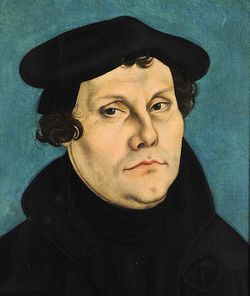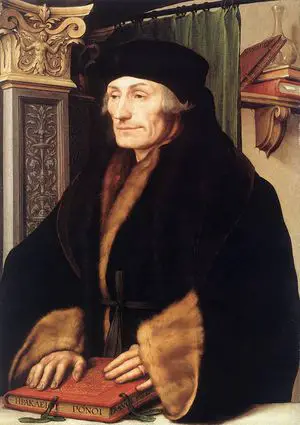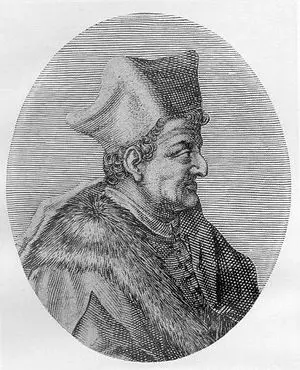What contributions did the writers and philosophers make to the Northern renaissance?

Did the Renaissance lead the Protestant Reformation? Without the Renaissance, information technology is difficult to imagine that the Protestant Reformation could have succeeded in Europe. The Renaissance placed human beings at the heart of life and had shown that this world was non just a 'vale of tears' but could be meaningful, and it was possible for people to live without reference to the divine.[1] The Renaissance or 'rebirth' was influenced by the ideas of the ancient past and it drew from Roman and Greek civilization to provide a solution to current problems.
The Renaissance was a Pan-European phenomenon and changed the elites' mental worldview in Europe and the emerging middle class across the continent. The cultural movement was to have a profound impression on people's worldview. The Renaissance produced the Humanists, who were educationalists and scholars; they sought truth and cognition by re-examining classical texts and the bible. The Humanists' ideas, the growth in textual analysis, and the Northern Renaissance changed the intellectual mural. They encouraged many Church reformers, such as Martin Luther, and they after broke with Rome and divided Europe into two confessional camps, Protestantism and Catholicism.
What was the Reformation

Sir Thomas More, Great English Humanists
The Reformation is the schism that divided the Roman Catholic Church and ended the old unity of Christendom. The origins of the Reformation were in an endeavor to reform the Church building, there had been many attempts in the past to reform the Church, but they had all failed. Past the early sixteenth century, there was a growing crescendo of calls for the Church's reform and an stop to the clergy's immorality and abuse.[2]
The Reformation was not an endeavor to divide the Roman Catholic Church building, just it was an effort to reform it. The Catholic Church's failure to reform and its attempts to suppress the Reformers meant that it drove many to establish their ain churches. The Reformation was an attempt to return to the original teachings and values of the early on or 'Apostolic' Church.[iii]
The Reformers claimed that only the Bible could teach and instruct men nearly the Word of God and had little regard for the received wisdom and dominance. Essentially, the but text that mattered was the Bible, and annihilation that was non in the Bible should be rejected. The Reformation placed more accent on the individual, and in words, people could not exist saved by expert works or sacrament but past 'religion solitary.'[4]
Ultimately, this estimation meant that the reformers rejected much of the Church'due south traditional teachings and resulted in at first a theological dispute between the reformers and the Church, especially in Deutschland. This dispute led to a total-blown schism in the Catholic Church building and the formation of separate Protestant Churches. The causes of the Reformation were manifold, but the Renaissance and the Humanist movement were crucial and indeed decisive.[5]
The Renaissance and Faith
The Renaissance is oftentimes seen as a secular and even heathen movement that was anti-Christian in many means. This view was certainly truthful in Italy, the birthplace of the Renaissance. The humanists were especially worldly and had little interest in the Church building.[vi] Several early Italian humanists, such as Petrarch, sought to reform the Church building, just his successors were largely secular in outlook and concerns. Many humanists were interested in reforming the Church, simply in the main, the Church and religion was non a major preoccupation of the Italian humanists. Nonetheless, there were many Renaissances, and the move took unlike forms in other countries.[7].
The ideas of the Italian Renaissance found their manner to the North of Europe at a time when at that place was a receptive audience for them. The Renaissance ideas and the works of classical writers were transmitted throughout northern Europe past the new printing printing and led to the Northern Renaissance. The Northern Renaissance is the term given to the cultural flowering north of the Alps, High german-speaking countries, France, England, and elsewhere.
Although influenced by the Italian Renaissance, the Northern Renaissance was a unique event and was different in some crucial regards.[8] It was also interesting in the ancient past. It believed that it offered an culling view of what life could be and could even provide practical guidance on how people should live and organize their societies. Withal, Northern Europe was much more religious in its concerns that the Italian Renaissance. [nine]
The Northern Humanists made the reform of the Church their chief preoccupation. Many German, English, and other Northern Humanists saw no contradictions between Christianity and the study of ancient cultures and believed that they could be reconciled.[10] The religious character of the Renaissance northward of the Alp was due in function to the continuing influence of the Church, different in Italy, where its, was in reject.
Despite the often sad land of the Church, the general population and even the elite remained very religious. The need for the reform of the Church was prevalent and was a particular preoccupation of the aristocracy. The want for Church building reform can be seen in the works of major Northern Renaissance figures such as Thomas More than or Rabelais, who satirized the abuses in the monasteries, in particular.[11]
The Northern Humanists inspired many people to become more than strident in their demands for reforms and the finish of abuses such as simony and clerical immorality. The works of Erasmus were particularly crucial in this regard. In his much admired and widely read book 'In Praise of Folly,' he lampooned and ridiculed corrupt clerics and immoral monks.[12]
The Northern humanists' attacks on the Church did much to encourage others to come across it in the new light. They became less deferential to the clergy, which led many of them to support the Reformers when they attempted to end the Church building's corruption.[13] Previously, many people believed that the Church building was non capable of reforming itself and accepted it. The humanists believed in reasons and the possibility of progress in all aspects of homo life. They argued that what was happening at present was not fated to exist and could be improved and inverse, opposite to the medieval view of an unchanging and fixed gild. This belief in the possibility of alter inspired many people to seek real and meaningful changes in the church, and when they failed to secure these, they sought to create alternative churches.[14]

Humanism and the Church

Lorenzo Valla - Italian Humanist
The humanists were intellectuals who were mostly interested in scholarly pursuits. They sought to understand the ancient world, find answers and knowledge, and study aboriginal texts to attain this. They wanted to go back to the original texts to understand the by and wanted to remove medieval corruptions and additions to texts. Their cry was 'Ad Fontas' in Latin, which is in English 'to the sources.'[15] They studied the ancient texts and adult textual strategies to understand the classical past's peachy works.
The Humanists were better able to understand the works of the by after developing ways to analyze texts. The development of textual criticism was not only of bookish interest just was to change how people came to run across the Church building and were ultimate to undermine the authority of the Pope. The Church's power rested on the authority of the Pope and the prelates, which was ultimately based on tradition.[sixteen]
The humanists employed their textual analysis and techniques to the bible and other works, and they made some astonishing discoveries. They provided evidence that undermined the claims of the Catholic Church building. Ironically, a humanist employed by the Pope was one of the showtime to discredit the traditional potency of the Papacy in the Renaissance. The Pope was non just a spiritual leader, but he claimed to take real political power. The Pontiffs were masters of the Papal States in primal Italy, and many even believed that Europe'due south monarchs were subject to their judgment. This was based on the Donation of Constantine, a document from the first Christian Emperor, which purported to evidence that he had ancestral his authorization to the Popes.[17]
This document was used to justify the Pope's temporal power. An Italian humanist named Lorenzo Valla began to study this document historically. He found that it was written in a Latin fashion from the eighth century and long after Constantine's death. Valla showed that the document was a forgery. This information and other revelations helped to weaken the Pope's authority and emboldened reformers to challenge the Church. Erasmus did much to discredit the Church'southward traditional theology when he discovered that the words in the Catholic Bible about the Trinity (that God has three persons) were not in the earliest versions.[xviii]
Erasmus argued that the Catholic Church had added the words to back up some statements agreed at a Church Council in the Roman era. Again, by returning to the sources, medieval abuse was discovered, and old assumptions proved to be false, which weakened the Catholic Church'south position.[19]
Papal Infallibility
The Humanists were not revolutionaries. They were often social conservatives and usually devout Catholics. This can be seen in the great Erasmus and his friend, the English statesman and author Thomas More. However, in their interrogation and examination of texts and their desire to purge them of any medieval corruptions or additions, they changed how people viewed the Church. The work of Erasmus and other scholars did much to weaken the Papacy.[20] Their examination of key texts revealed that much of the say-so of the Church building was built on flimsy foundations. This led many to challenge the power of the Pope. Equally the Church building leader, he was infallible, and his words on secular and religious issues were to be obeyed without question.
After the humanists' revelations, many of the faithful began to wonder if the Pope. 'as the heir of St Peter' was infallible and should he be rendered unquestioned obedience.[21] The reformers under the influence of the Humanists began to examine the Bible, which they saw as the unquestioned Word of God, to find answers. They became less inclined to take the words of the Pope as law and argued that only the Bible was the source of authorisation. Similar the Humanists, they decided to become back to the 'sources,' in this case, the Bible. They somewhen came to see the Bible equally the only source of say-so. They increasingly began to view the Pope and the Catholic Church building every bit having distorted the Gospels' message.[22] This belief shortly gained widespread currency among many Reformers and those sympathetic to them in Germany and elsewhere.
Determination
The Renaissance was a cultural flourishing that promoted secular values over religious values. Nevertheless, in Northern Europe, the ideas of the Renaissance were to take on a religious character. The ideas of the Italian humanists, such as textual analysis, the use of critical thinking, and rejecting authority that was non sourced on reliable evidence were taken upwards past Northern Humanists who applied them to the Church.[23]
The Northern Humanists sought to reform the Church and were generally pious men. Nonetheless, the humanists possibly unintentionally weakened the Papacy and its theoretical underpinnings. In their examination of cardinal texts and particularly the Bible, they exposed many primal assumptions equally imitation. This was to lead to a widespread challenge to the idea of Papal Infallibility and the Church building's ability construction.[24] The Renaissance also encouraged people to question received wisdom and offered the possibility of change, which was unthinkable in the middle ages. This encouraged the reformers to tackle abuses in the Church, which ultimately led to the schism and the end of Christendom's old idea.
References
- ↑ Giustiniani, Vito. "Ho, mo, Humanus, and the Meanings of Humanism," Journal of the History of Ideas 46 (vol. 2, April – June 1985), p 178
- ↑ Payton Jr. James R. Getting the Reformation Incorrect: Correcting Some Misunderstandings (IVP Academic, 2010), p. 78
- ↑ Payton, p. 113
- ↑ Payton, p. 118
- ↑ Patrick, James. Renaissance and Reformation (New York: Marshall Cavendish, 2007), p. 113
- ↑ Patrick, p 115
- ↑ Payton, p. 45
- ↑ Patrick, p. 123
- ↑ Chipps Smith, Jeffrey. The Northern Renaissance. (Phaidon Press, 2004), p. 167
- ↑ Chipps, p 119
- ↑ Patrick, p. 145
- ↑ O'Neill, J, ed. The Renaissance in the North. New York: The Metropolitan Museum of Art, 1987), p. 5
- ↑ Collinson, Patrick. The Reformation: A History (Longman, London, 2006), p.87
- ↑ Collinson, p. 56
- ↑ Payton, p. 57
- ↑ Patrick, p. 121
- ↑ Davies, Tony. Humanism (The New Critical Idiom). (University of Stirling, Uk. Routledge, 1997), p 34
- ↑ Davies, p 67
- ↑ Davies, p. 134
- ↑ Payton. P. 34
- ↑ Patrick, p 117
- ↑ Collinson, p. 115
- ↑ Chipps, p. 67
- ↑ Chipps, p. 17
Updated, January 28, 2019.
Admin, Ewhelan and EricLambrecht
Source: https://www.dailyhistory.org/How_did_the_Renaissance_influence_the_Reformation
0 Response to "What contributions did the writers and philosophers make to the Northern renaissance?"
Post a Comment